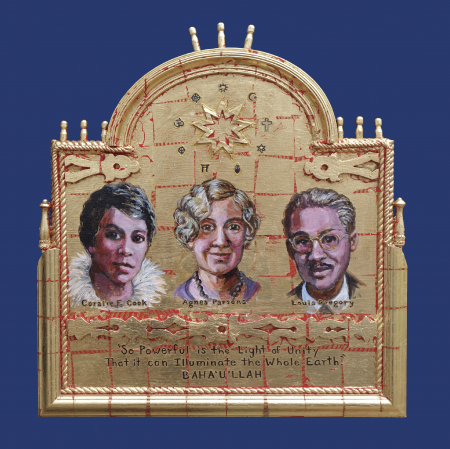The American Baha’i faith community was one of the most progressive religious groups in the area of interracial cooperation during the early part of the 20th century. Its teachings on racial cooperation and unity are based on the writings of its prophet-founder, Baha’u’llah whose central theological principle was the unity and oneness of humankind. He believed that the very purpose of his appearance and claim as a messenger of God was to unite the human family. The nine-pointed star with symbols of the world religions reflects Baha’u’llah’s commitment to that belief.
The early American Baha’i community was composed of predominantly white people who were just begin- ning to grasp the historic implications of the Baha’is’ teaching for racial unity. In 1911, the founder’s son Abdu’l-Baha sent a message to the University Races Congress in London in which he stressed the importance of diversity within the human family and com- pared humanity to a flower garden adorned with different colors and shapes that “enhance the loveliness of each other.”
A year later he went on a speaking tour throughout the United States where he attempted to demonstrate the importance of the Baha’i belief in the importance of love and unity between all members of the human race, especially blacks and whites. At a fashionable Washington D.C. luncheon in his honor, he arranged for a well known Black Baha’i, Louis Gregory, to sit with him at the head table. No doubt this gesture of racial amity was a surprise to the white luncheon guests who were among Washington’s social and political elite. Gregory, born June 6, 1874 in Charleston, S.C., became a lawyer and an activist member of the Baha’i faith.
Because Abdu’l-Baha believed not only in the equality and amity between Blacks and whites, he also affirmed interracial marriage. He encouraged Gregory to marry Louisa Mathew, a white Baha’i from England. While some Baha’is doubted such a union could succeed in a segregated society, their marriage lasted until they died forty years later and became a Baha’i symbol of interracial love.
Several years after Abdu’l-Baha had returned home to Palestine, he initiated a plan to address the racial crisis he had observed in the U.S. A significant part of his plan was the organization of a series of large, well-publicized interracial meetings aimed at promoting “racial amity” between Black and white Americans. The first of these National Race Amity Conferences was held in 1921 in Washington, D.C. With Louis Gregory as a key organizer, Abdu’l-Baha asked Agnes Parsons to help promote this important event. As a devoted Baha’i and prominent white socialite, she was able to attract influential figures from both the white and Black communities. Parsons also attracted Coralie Franklin Cook, a well- known Black woman, to this conference. Born into slavery in Virginia, she was the first descendant of Sally Hemmings and Thomas Jefferson to attend college. She married George W. Cook, dean at Howard University, where she later became chair of the Oratory Department. Appointed to the D.C. Board of Education, a founder of the National Association of Negro Women, and notable patron of the arts, she gave a presentation on Negro poets at this First Race Amity Conference. Over the last 100 years these race amity conferences would be a hallmark of the American Baha’i community’s contribution to American race relations.

